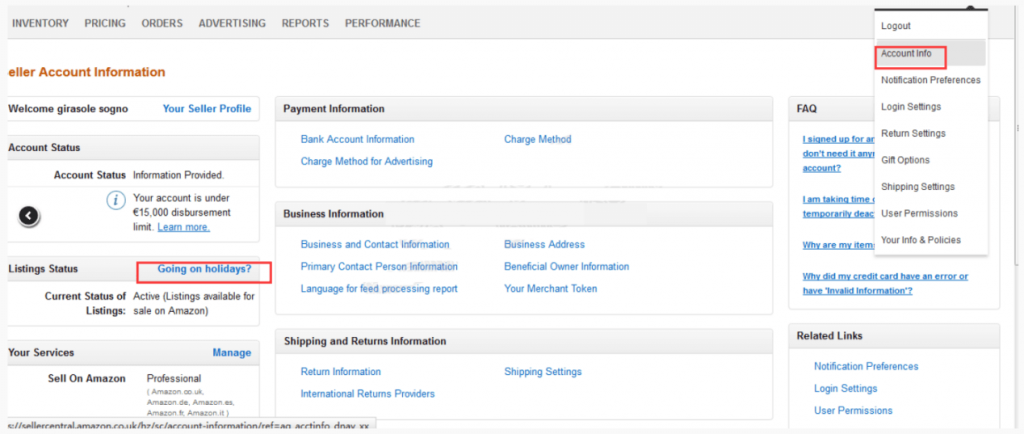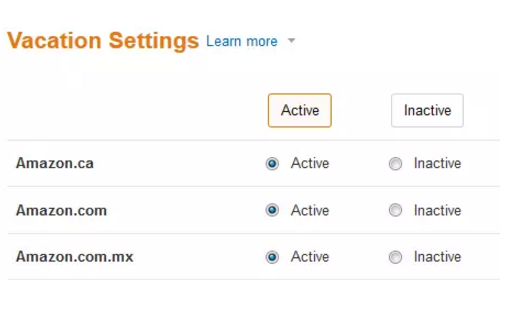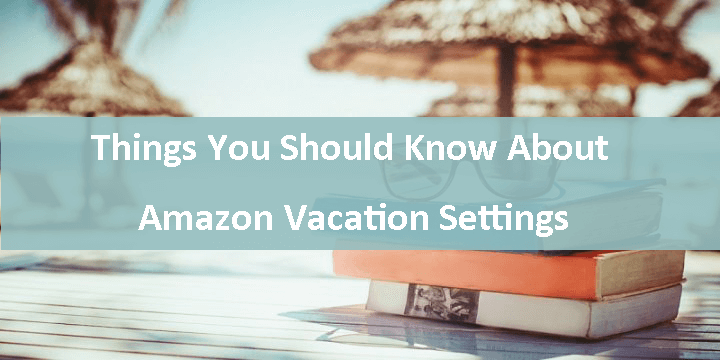Starting a business and growing it takes hard work and dedication. Long working hours, sleepless nights, and no vacations are part of the picture.
But what if I were to tell you that Amazon Vacation Settings can help you grow your business while you’re enjoying some well-deserved time off?
It sounds tempting, doesn’t it?
Read on to find out more about the vacation mode on Amazon, its pros and cons, how to set it up, and how to behave while you’re away.
What Is Vacation Mode on Amazon?
The vacation mode on Amazon is a tool the marketplace offers sellers who want or have to take some time off their business. It lets you inactivate your listings for a shorter or longer period of time, so you won’t risk getting negative feedback due to unresponsiveness while you’re away.
In short, Amazon vacation settings give you the possibility to put your account on hold instead of closing it down.
Why Do You Need Vacation Mode?
As a seller, the vacation mode gives you the possibility to take a break from your business without risking to lose your ranking.
This mode helps you keep your brand reputation intact while enjoying the beauty of a pristine beach, for example.
You can use the vacation mode in two ways:
- If you’re fulfilling the orders yourself (FBM), the Amazon vacation settings let you inactivate your listing. It may take up to 36 hours for Amazon to remove your listing from the website, and you can activate it whenever you wish from your Seller Central account. This option keeps both your listing and your store safe.
- If your products are fulfilled by Amazon (FBA), the vacation mode allows you to keep your listing active, so you can still sell and grow your business while you’re away. In this case, however, you’ll still have to dedicate a minimum amount of time to check your seller account performance and buyer messages, to ensure that everything’s running smoothly.
See also: FBA vs. FBM: Which Fulfillment Service is Best for You?
What Are The Downsides Of Vacation Mode?
When you’re stressed and tired after a long year of work, it’s tempting to put your business on vacation mode.
Before you do so, though, take your time to find out which are the downsides.
You can make more sales when everyone’s on vacation.
This isn’t necessarily a drawback, especially if you decide to go on vacation when everyone else is at work.
Timing is key, and you can still have a lot of fun in the off-season too. Nevertheless, scheduling your time off based on your customers’ behavior can be frustrating sometimes.
It will lead you to lose margin while you will still have to pay other fees as an Amazon seller.
You could counteract this fact if you opt for FBA, but in this case, the fees could be higher, and you’ll still have to work on vacation.
You will lose new and old customers who want to buy from you. Since your listing will not be active, you won’t be able to find new customers.
At the same time, your old customers who want to buy from you won’t be able to find your listing either.
Indeed, inactivating your listing while on vacation could have negative repercussions on customer retention and loyalty.
Things You Should Do During Vacation Mode
While Amazon vacation settings give you some peace of mind, you can’t just get away and forget about your business.
Here is a cheat sheet of things you should do while on vacation mode.
- Don’t just leave your listing as it is. Keep an eye on your store and make sure to respond to any negative reviews or feedback in a timely manner. That’s especially important if you want to prevent a big drop in your ratings and overall ranking.
- Never log in to your Amazon account from different devices. Perhaps the easiest way to ensure that you’ll always check from the same device is logging in to your seller central from a mobile device, such as a smartphone or tablet. Using different devices may lead to an account association and get a suspension.
- Don’t activate the vacation mode if you have any pending orders or unsolved customer issues. As mentioned above, timing is key. Plan your vacation and activate the vacation mode at least a week before leaving. This will give you plenty of time to deal with any last-minute orders before your listing becomes inactive.
- Even if you’re on vacation, you must still comply with Amazon’s rules and respond to any messages from your buyers within 24 hours. Utilizing an email auto-responder tool with a nice message telling the customer you’ll get back to them as soon as possible is usually enough to keep both Amazon and your buyers happy.
- Use an email auto-responder tool to notify your customers about the upcoming vacation and the holiday delay they might expect if they place an order while you’re away. If buyers know what to expect, it’s less likely to get negative feedback for late delivery or response.
For this purpose, you can use a tool such as AMZFinder.
This email automation tool can help you send afters-sales emails automatically while monitoring the incoming reviews and seller feedback.
The tool also sends review report notifications, so you can solve any issues in a timely fashion.

How To Set Up Amazon Vacation Settings
Before diving right into the matter, we must say that Amazon vacation settings are a great thing for sellers fulfilling their orders by themselves (FBM).
In this case, it is recommended to turn on the vacation mode even if you’re away for a short time, such as a week or two.
If you’re fulfilling the orders through Amazon FBA and don’t mind checking your account now and then, turning on vacation mode may be unnecessary.
In fact, Amazon will still handle the shipping and provide customer support for your orders even when you’re away.
You’ll still have to check your stock and respond to any feedback or reviews as quickly as possible.
If you’re an FBA seller and want total peace of mind while you’re away, turning on the vacation mode could be a good choice.
There are three ways to manage vacation mode on Amazon, so let’s have a more in-depth look at them.
Set Up Vacation Mode From Your Seller Central
Log into your Amazon account and follow the steps below:
1.Click on Settings -> Account Info

2. Find Listing Status

3. Change the status of all your listings to Inactive.
You can reactivate all listings after the vacation in the same way, but clicking on Active rather than Inactive.
Set Your Inventory to Zero
Another way to prevent headaches while you’re on vacation is by setting your inventory to zero.
Log into your account and follow the steps below:
- Click on Inventory
- Go to Manage Inventory
- Set Available: 0
Your customers won’t be able to place an order until you go back and change the inventory value to 1 or higher.
Extend The Handling Time
You can also avoid negative feedback by extending the handling time to any time that suits you.
How you can make these changes depends on what method you used to set your handling time in the first place.
- If you have used an Excel table to upload your items in bulk, then you can change the handling time in the same excel file and upload it again to change all listing at one time.
- If you have uploaded your listings one by one, then you need to check each listing and change the time separately; in this case, follow these steps: Inventory -> Manage Inventory -> Action -> Edit Details -> Handling Time.
In case you want to use an excel template, you can find one in your seller central account.
Go to Inventory > Add Products via Upload > Download Template.

Before you do these changes, it is important to know that inappropriate handling or delays can lead to negative feedback, which may have a bad impact on your store’s performance.
Changing the handling time could be a great solution if you only plan to go on a short vacation.
Even if you advise your customers of longer waiting times, it may still draw negative reviews.
If you plan to stay away for longer, setting your inventory to zero or activating the Amazon vacation settings could be a better choice.
Conclusion
Amazon vacation settings are an excellent tool to use every time you want to take a break from your business.
They are designed to give FBM sellers peace of mind on those moments when fulfilling an order is inconvenient, and can also be used by FBA sellers who don’t want to monitor their account on vacation.
We hope this guide can help you make the right decision so that your business can thrive even during your well-deserved rest periods.
You may also like:
The Ultimate Guide to Sell With Amazon Wholesale
Shopify vs. Amazon: Which Platform is Profitable to Sell on?
Your Complete Business Guide for Selling on Amazon Europe
How To Buy Cheap UPC Codes On Amazon
Amazon Project Zero: The Best Tool to Remove Listing Hijackers

